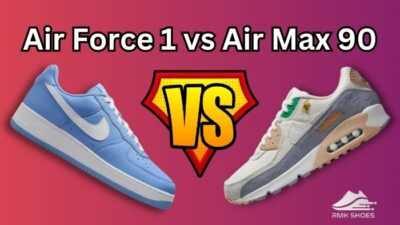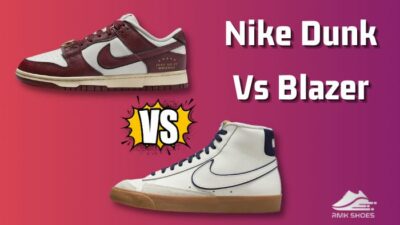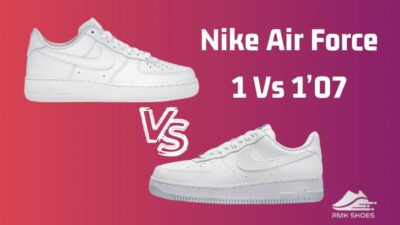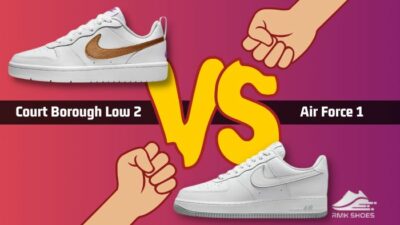It’s always better you do your job with equipment designed to serve their purpose.
You may think of the term MAKESHIFT, but I can assure you MAKESHIFT isn’t always right.
Let’s say you’re officially tired of your unfit life, and it’s time for a change. You want to hit the gym or start running. One of the essential things for your desired activity is a fine pair of shoes.
If you plan on running, then you must get a pair of RUNNING SHOES and vice versa.
As a beginner, you may come across the confusion of “which pair of shoes to choose?” as they look quite similar.
Well, worry not, in this guide, I’ll shed some light on both the pair of shoes, and by the end, you’ll have all the answers to your questions.
Training Shoes vs Running Shoes: KEY DIFFERENCES
Before I begin the elaborations, here’s a list of the key differences between Training Shoes and Running Shoes.
- Training Shoes are tailor-made for gym enthusiasts where one can easily make the transition from lifting weights to jogging on a treadmill and step aerobics.
- Training Shoes usually offer additional ankle support for both lateral and forward movement.
- Running Shoes usually have higher heel drops than Training Shoes.
- Running Shoes have more cushioning in the heel area (the point of impact).
- More heat’s generated while running. As a result, they’re made with a higher amount of mesh to keep your feet cool during exercise.
Check out our separate post: Do Hunter Rain Boots Run Big
What Are Running Shoes?
As the name suggests, Running Shoes are designed for the purpose of running and is one of the most common types of athletic shoes.
They support heel to toe movement and endure the considerable amount of forces acting on your feet while running.
Lately, Running Shoes have become more prominent in terms of lifestyle, with their function and form going through considerable improvement.
They offer best-in-class comfort with their impressive built quality, which adds to their durability. As a result, Running Shoes become a staple item as a fashion accessory that you can wear regularly.
In contrast to other shoes Running Shoes boast extra cushioning for smoother landing on a hard surface. They’re able to absorb much of the shock between the ball of your feet and the ground. Be it running in the morning or a marathon, or running on a challenging surface, they’re made to endure the hard impacts and maximize your performance.
Crafted with lightweight and breathable fabric, you can use them for a longer time without having to worry about the inside getting hot and foot fatigue. Running Shoes can be used on multiple terrains which means they’re suitable for almost any type of surface you want to run on without having to worry about discomfort.
If you’re into running at night, there are variants equipped with reflective strips that enhance your visibility. All in one, they’re a complete package.
Do check our latest post Do Koolaburra Uggs Run Big
WHAT ARE TRAINING SHOES?
Training Shoes are designed for lifting weight, high-intensity gym workouts, strength training, agility training, and more. To support these activities Training Shoes are equipped with features that are different from Running Shoes.
To provide the utmost stability and lateral support, Training Shoes have broader and flatter soles. Most gym exercises require side to side movement, for which lateral support is a must.
The flatter heels mean lower heel drop. The heel drop is one of the key features that distinguish the two shoes.
As a result of the lower heel drop, you can easily transition from squatting to standing. It’s incredibly essential to perform squats and lift weights. You get the additional support required to perform these exercises by putting lesser stress on your body.
When you’re running in a particular direction, traction is not that fundamental, but when you’re cutting in from side to side or putting in that sudden shift on your weight, you’ll be needing proper grip. Training shoes offer the required grip you need for such activities.
If you got climbing on your list, then don’t worry; training Shoes offer grip at the sides to support you, too. To provide overall stability, they usually have flatter soles than Running Shoes.
Also read, Do Timberland Boots Run Big
Training Shoes Vs. Running Shoes – The Differences
The shoes are almost identical in terms of looks, but they differ in terms of properties (obviously!). For your better understanding, I’ve categorized the differences.
You should have no problem in differentiating between the two once you know them.
Here’s how they differ.
Go through our epic guide on how to Clean The Soles of Dance Shoes
Fitting
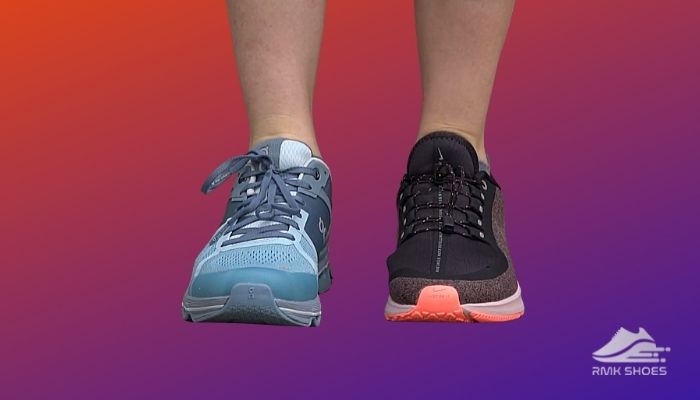
Both the footwear offer different fittings due to the ways they’re made. It’s essential you know how each of them fits as it may have a significant impact on foot’s health.
Here’s how they should fit.
Check out our separate post on Adidas Shoes Fitting Guide
Running Shoes
Your Running Shoes should have a higher heel drop for extra cushioning. At times buying a size bigger than your actual size is recommended as you need sufficient room for your toes to wiggle. If you get an excellent wiggle room in your exact size, then great!
Make sure to check the width and length by pressing down your thumb around the toes to the ball of your feet while standing. There should be a space of about half to a full thumb’s width for the best fit. Keeping these in check, you should be ready to go.
Training Shoes
You should look for a comfortable upper and flexible midsole in your Training Shoes. The reason is you’ll be doing multidirectional movements so that you get proper backings from your shoes.
As mentioned earlier, these shoes have lower heel drops, which puts you closer to the ground to push off and balance properly. The lightweight nature of the boots allows you to move quickly without any setbacks.
Use your thumb to ensure proper spacing in the front. For best fit, provide a thumb’s width between your longest toe and the front of your shoe.
Heel Drop
Running Shoes are equipped with higher heel drops. Heel drop is the difference between how high a shoe is in the heel and the forefoot.
Higher heel drops reduce the stress on calf muscles and Achilles tendons. Training does not involve high impact landing hence the difference.
SHOE MATERIAL
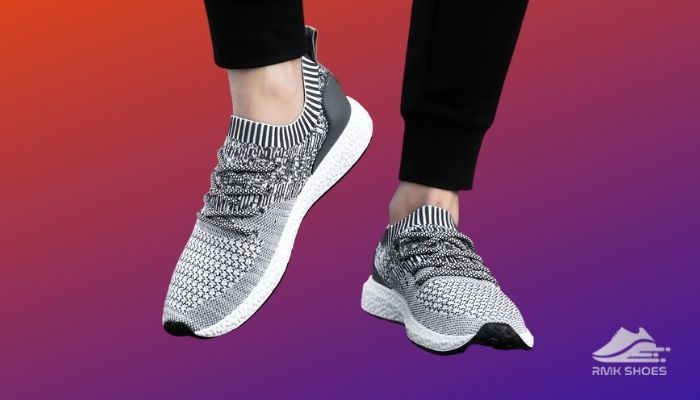
Running requires constant/fast movement, as a result, the inside of your shoes heats up, and sweat. To prevent this from happening, you’ll need a pair of shoes that have breathable material.
Read more on how to Clean The Soles of Dance Shoes
Running shoes usually have more breathability compared to Training shoes as they’ve more mesh in the upper.
Heel Counter
I highly recommend that the body of your athletic shoes is up to your requirements. An essential part of any athletic shoe is the heel counter. It prevents your heel from slipping. It’s vital for activities that require frequent heel movement.
Running requires more heel movement compared to training. As a result, they have a more substantial heel counter.
SOLE
Compared to Running Shoes, Training Shoes have flatter soles that support a whole range of movement and are more flexible.
On the other hand, Running shoes have a stiffer sole, which is ideal for the heel-to-toe movement.
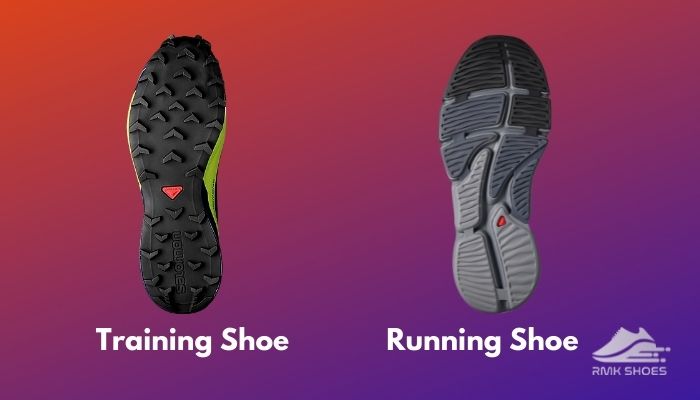
Soles in Training Shoes tend to be heavier to provide better stability.
Cushioning
Running shoes are equipped with extra cushioning compared to Training shoes. Running requires high-impact landing; hence they boast the added cushioning in the ankle area.
Traction
Training Shoes offer more traction in contrast to Running Shoes. You normally run in a straight line; the grip isn’t as necessary here. But training requires lateral movements or sudden shifts in weight for which good traction is essential.
WHAT HAPPENS WHEN YOU WEAR THE WRONG SHOE?
Wearing the wrong type of shoes can lead to discomfort and injuries (especially if you have other foot-related issues).
If you have prior foot issues, the wrong type of shoes will only help it to escalate. Your feet must be supported in the right way for any activity you do.
Also, follow our guide on How to Clean Yellowing Soles
Let’s look at a wider angle at the difficulties you might encounter.
INJURIES
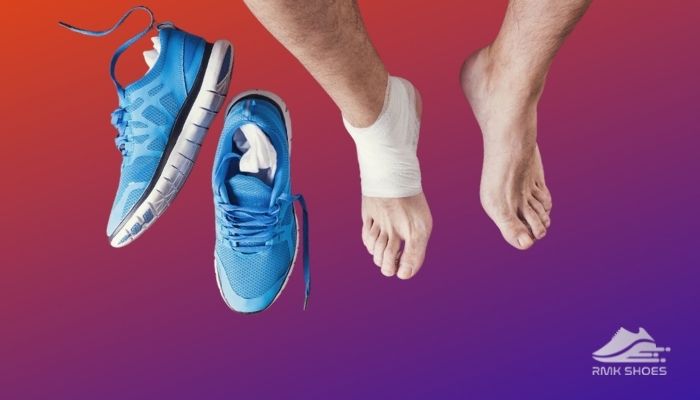
Running shoe isn’t mainly built for lateral support. The higher heel drop in running shoes ensures proper backing for the heel to toe movement. Due to the lack of lateral support, you may come across sprained ankles while training.
Running demands, very well-cushioned shoes. Training shoes are relatively low on cushioning. If you run in training shoes, then there’s an excellent chance you may get plantar fasciitis or stress fractures.
Plyometric exercise requires precise landing, the extra support and cushioning in running shoes can lead to an ankle injury, so you should avoid running shoes for such activities.
It’s essential to wear shoes according to pronation; otherwise, there’s this good chance of getting tendonitis.
And last but not least, make sure to wear the “right-size.” Too small shoes can cause your toenails to turn black upon falling off or bruising. You may also get bunions or calluses. Similarly, wearing too large shoes can contribute to pain in the ball of the foot.
Discomfort
The wrong shoe just won’t feel right. You won’t get the proper comfort or support for running in training shoes and vice versa.
You may come across blisters, soreness, and pain. You’ll feel like your shoe’s getting in your way.
Compromised Performance
You won’t have the best of performances in the wrong shoes. Running requires extra cushioning in the heel area, less grip for swift heel-to-toe movement, and higher heel drop to hit the ground from the get-go. You won’t get these features in Training Shoes, which will ultimately lead to your performance drop.
FACTORS TO CONSIDER IN ATHLETIC SHOES AND ITS IMPORTANCE
If you want to get things right from the get-go, you must check for some essential features in the athletic shoes that hold the key to your athletic endeavor.
One decisive reason athletic shoes are different from regular shoes is that they offer some distinct features. If you get them right, let’s say you’ve got “step-one” correct.
Here’re the features you should look out for.
Gait Analysis
Arguably the most crucial factor when purchasing any kind of shoes is to get your gait analysis done. Gait is how you walk or run. Gait analysis allows you to know whether you pronate or supinate. You can do it by yourself or in stores. There’re running shoes to counteract supination and pronation.
Also related: Shoe Cream vs Shoe Polish
Proper Fitting
A pair of ill-fitted shoes can make your entire experience bad and often discouraging. Not ensuring the proper fit can lead to injuries and deprive you of advantages such as motion control or cushioning.
Try to shop during the later part of the day as your feet swell up and give you a better fit. Keep in mind sports shoes do not need to be broken into (doesn’t require a break-in period). The fitting should be comfortable right from the get-go; any sort of discomfort indicates “not suitable for you.”
Material
Your feet will get hot, whether you run or train; for proper ventilation, athletic shoes should be equipped with appropriate breathable material. You may even develop a permanent odor.
Manufacturers tend to use mesh as upper and other materials such as cotton or canvas for proper breathability. Make sure the fabric’s also durable and can endure high impact exercise.
Lacing
Compared to regular shoes, the lacing in athletic shoes tends to be different. You might be wondering, what does lacing have on shoes? Well, the material of the laces has different impacts.
They can make your entire process faster and make the loops tighter. You can also adjust the tightness according to your liking in specific activities.
Style/Aesthetic
Athletic shoes bear quite the aesthetics, don’t they? But let’s be honest, not all of them are up to the mark. These shoes are versatile enough to be worn with everyday outfits.
You’re a fashion-conscious person and do not compromise with your style; then, it’s best to choose a pair that satisfies your taste and complements your attire.
You may also like to read: Can You Run In Cycling Shoes
Frequently Asked Questions
Can you wear Running Shoes casually?
Yes, you can wear Running shoes casually. It’s quite popular. A lot of people wear these shoes regularly. They’re stylish, aesthetic, and comfortable. Tick a lot of boxes, don’t they?
Are Training Shoes suitable for walking?
Simply no! They just don’t work. Your shoes need to be flexible for this activity. Training Shoes just aren’t that flexible. Running shoes or light walking shoes should serve you just fine.
Can you lift weight in Running Shoes?
For light weight lifting, yes, but it’s a big no for heavy weight lifting. For heavy weight lifting, you’ll need shoes that provide you with the utmost stability. Sadly Running Shoes lack that.
Can you squat in Running Shoes?
I won’t recommend it but if you want to do it anyway then sure! Running Shoes are shaped at the bottom for swift kinetic movement. Simultaneously, Training Shoes are flatter and provide a strong grip for vertical direction such as the squat.
Conclusion
You’ll always get better results using specific equipment for any activity. It’s no different for Training or Running. You’ll always get enhanced performance if you use Running Shoes for running and Training Shoes for training.
They may look the same but they’ve differences. The preliminary ones are heel drop, cushioning, and flexibility. I hope your job of distinguishing between the two has been made easier. Do let us know about your experience. Cheers.

